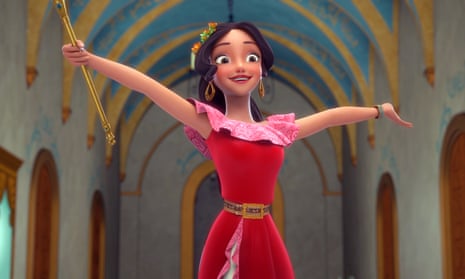As a kid, my go-to Halloween costumes were Esmerelda, Jasmine or Pocahontas – or as I’ve deemed them: the Disney Princess Brown Girl Club. I remember being excited about dressing up as these princesses because my body in these costumes could accurately replicate a Disney Princess. It felt good to be included in the club, to have a seat at the table, even if the brown women at the table were a collection of slapdash caricatures created to sell merchandise.
I have mixed feelings about Friday’s premiere of Elena: Princess of Avalor, a new television show on the Disney Channel featuring the rare Latina princess. In an interview, head writer Sylvia Cardenas Olivas has stated feeling an immense amount of pressure trying to “get Elena right” so that she can, in some way, be “everybody’s princess”. So although she has been a long time coming, I fear Disney will flatten and generalize the diversity of Latino identity.
Elena isn’t indigenous or Afro-Latina or from a specific Latin-American country. She is a thin, light-brown Latina princess from Avalor, a made up Latin-American-esque kingdom that exists in a pre-colonial, pre-Columbian world. This, by the way, is baffling: how does one understand their Latino identity without acknowledging colonialism? While the backdrop of Elena is influenced by Mayan culture and Chilean folklore, her race and ethnicity is otherwise based in Disney fantasy.
It’s almost romantic to think that Disney has taken so long to have a brown-skinned Latina Princess because we are just so hard to get right. Like Elena, I am a mixture of Latino cultures.
When speaking Spanish, my accent is some parts my father’s Colombian paisano, my mother’s Guatemala city, and whatever the hell contrived accent I learned in Spanish class. When people ask me which side of myself I identify with more, I can’t give them a definite answer. I understand my identity to be something that is sloppily mashed together – like the food my Abuelita sneaks over from her trips to Guatemala. I know what it is, and I know the way it is supposed to taste, but travel and time has made it kind of just look like a weird thing in a plastic container.
But every culture is hard to get right and define, and Disney has certainly mangled them before. I don’t think we can make progress by waiting for “everybody’s princess”. The only way we can get full, accurate representation is by shouting ourselves into existence and carving stories in places that were not meant for us. As a writer, I try to remember that the stories I tell as a Latina woman are not everyone’s. I am not the voice of all Latinas. However, I hope that my words make it seem more possible for others to tell their own stories. Disney is doing the work but not enough of it.
And yet. Watching the Elena trailer, I cry when her grandmother calls her mija, meaning “my dear” or “my daughter”. I think of all the dears and daughters watching, their eyes wide, their hearts still believing in magic, soaking every image and sound in. I think of my niece, who last year dressed up as Elsa from Frozen for Halloween, a fake silver braid falling down her back.
I remember that there is so little of us reflected in the media that any resemblance – however messy and inaccurate – can feel like someone calling us home. It’s a relief to have a costume that fits us, to buy a little doll that looks like us. It can feel good to have a version of ourselves on a backpack, even if it is a caricature.
I am not advocating for blind endorsement of Disney’s merchandising as a solution to Latina media erasure. But I do wonder if my niece will watch Elena – a young, loud, ambiguously brown cartoon princess, ruling a kingdom without a man – and feel like she, too, can be royal and magical in her body.
